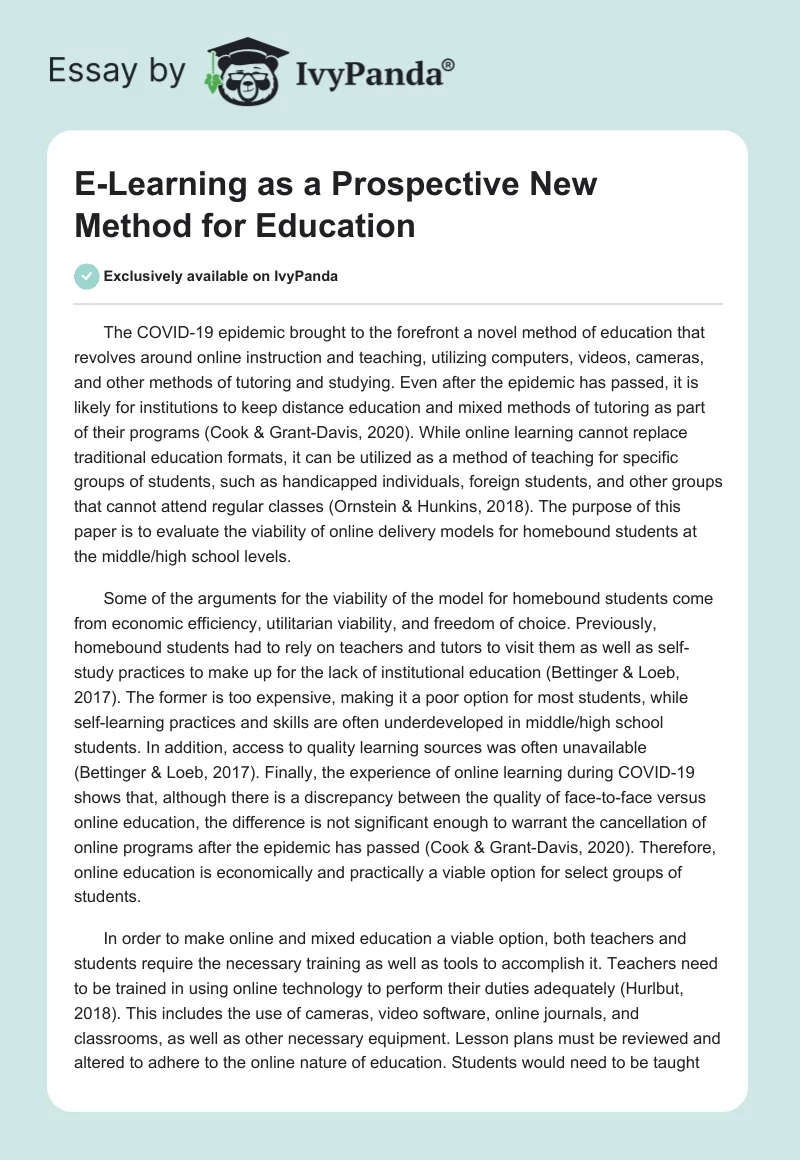The COVID-19 epidemic brought to the forefront a novel method of education that revolves around online instruction and teaching, utilizing computers, videos, cameras, and other methods of tutoring and studying. Even after the epidemic has passed, it is likely for institutions to keep distance education and mixed methods of tutoring as part of their programs (Cook & Grant-Davis, 2020). While online learning cannot replace traditional education formats, it can be utilized as a method of teaching for specific groups of students, such as handicapped individuals, foreign students, and other groups that cannot attend regular classes (Ornstein & Hunkins, 2018). The purpose of this paper is to evaluate the viability of online delivery models for homebound students at the middle/high school levels.
Some of the arguments for the viability of the model for homebound students come from economic efficiency, utilitarian viability, and freedom of choice. Previously, homebound students had to rely on teachers and tutors to visit them as well as self-study practices to make up for the lack of institutional education (Bettinger & Loeb, 2017). The former is too expensive, making it a poor option for most students, while self-learning practices and skills are often underdeveloped in middle/high school students. In addition, access to quality learning sources was often unavailable (Bettinger & Loeb, 2017). Finally, the experience of online learning during COVID-19 shows that, although there is a discrepancy between the quality of face-to-face versus online education, the difference is not significant enough to warrant the cancellation of online programs after the epidemic has passed (Cook & Grant-Davis, 2020). Therefore, online education is economically and practically a viable option for select groups of students.
In order to make online and mixed education a viable option, both teachers and students require the necessary training as well as tools to accomplish it. Teachers need to be trained in using online technology to perform their duties adequately (Hurlbut, 2018). This includes the use of cameras, video software, online journals, and classrooms, as well as other necessary equipment. Lesson plans must be reviewed and altered to adhere to the online nature of education. Students would need to be taught the necessary software as well (Hurlbut, 2018). It is very important that both parties have access to computers, video cameras, software, and other equipment. Acquiring those can be difficult for individuals coming from poor families (Cook & Grant-Davis, 2020). Finally, online teaching would require a different set of standards for the quality of learning and testing since the teacher would not be able to supervise students directly.
Personally, I would implement an online learning model in my current situation. It will allow me to keep myself safe from COVID-19 by limiting my interactions with others. It will also protect me from potential issues with fellow classmates, such as bullying (Ornstein & Hunkins, 2018). Being able to access my school program from my computer would allow me to save time traveling to and from school. It would also allow me to record lessons and come back to them should I need a reminder of what happened during class. Finally, I think it would drastically reduce all of the expenditures associated with schooling and give me more time and personal freedom without harming my potential as a learner (Hurlbut, 2018). Overall, I think that the need to gather children in large government buildings is a model that slowly but surely outlives itself and that online education is the future.
References
Bettinger, E., & Loeb, S. (2017). Promises and pitfalls of online education. Evidence Speaks Reports, 2(15), 1-4.
Cook, K. C., & Grant-Davis, K. (2020). Online education: Global questions, local answers. Routledge.
Hurlbut, A. R. (2018). Online vs. traditional learning in teacher education: A comparison of student progress. American Journal of Distance Education, 32(4), 248-266.
Ornstein, A. C., & Hunkins, F. P. (2018). Curriculum: Foundations, principles, and issues (7th ed.). Pearson.

 4.00
4.00
